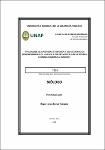| dc.contributor.advisor | Peña Hidalgo, Marx | |
| dc.contributor.advisor | Espinoza Campos, Freddy Orlando | |
| dc.contributor.author | Burga Vásquez, Roger Jesús | |
| dc.date.accessioned | 2019-08-15T18:09:12Z | |
| dc.date.available | 2019-08-15T18:09:12Z | |
| dc.date.issued | 2018 | |
| dc.identifier.other | 615.321 B94E 2018 | |
| dc.identifier.uri | http://repositorio.unapiquitos.edu.pe/handle/20.500.12737/6333 | |
| dc.description.abstract | La evaluación en citotoxicidad es considerada como un estudio base, el cual permite al investigador utilizar la información generada para posteriores estudios en farmacología. El objetivo del presente estudio fue evaluar la actividad citotóxica in vitro con extractos hidroalcohólicos de 5 especies vegetales (Sapium sp., Virola sebifera, Virola albidiflora, Caryocar glabrum y Tapirira guianensis). Se utilizó un método cuantitativo - experimental de bioensayo con nauplios de “Artemia franciscana” (Branchipus stagnalis). Las muestras vegetales fueron recolectadas en la Reserva Comunal Tamshiyacu-Tahuayo en dos visitas realizadas. Asimismo, estas han sido identificadas taxonómicamente en el Herbarium Amazonense del CIRNA (Universidad Nacional de la Amazonía Peruana); fue secado y pulverizado en las instalaciones del Instituto de Medicina Tradicional EsSalud (IMET). La preparación del extracto y la evaluación citotóxica se realizó en los ambientes del Laboratorio de Fitoquímica en el IMET mediante el método de bioensayo nauplios de Artemia franciscana (B. stagnalis). Cada muestra fue macerada por un periodo de 7 días en una solución hidroalcohólica (7:3) teniendo como solvente al etanol, luego se procedió a filtrar y a concentrar en el rotavapor. Los principales resultados del estudio indican el grado de citotoxicidad: C. glabrum (81,6%), T. guianensis (78,8%), seguido por V. sebifera (75,25%), V. albidiflora (75%) y Sapium sp (71%) frente a B. stagnalis. Así mismo, estos resultados nos permitieron determinar la concentraciones letales (CL50) derivadas de cálculos estadísticos: 14,18mg/L, 21,17mg/L, 48,75mg/L, 50,67mg/L y 80,25mg/L; para las especies C. glabrum, T. guianensis, V. sebifera, V. albidiflora y Sapium sp. | es_PE |
| dc.description.abstract | The evaluation in cytotoxicity is considered as a base study, which allows the researcher to use the information generated for further studies in pharmacological. The purpose of this study was to assess the in vitro cytotoxic activity with hydroalcoholic extracts from 5 vegetal species (Sapium sp., Virola sebifera, Virola albidiflora, Caryocar glabrum y Tapirira guianensis). The biotest method was used with “Artemia franciscana” (Branchipus stagnalis) nauplii. The vegetal samples were collected from the Tamshiyacu-Tahuayo Regional Conservation Area, where we carried out two visits. Likewise, these have been taxonomically identified in the Herbarium Amazonense from the CIRNA (Universidad Nacional de la Amazonía Peruana); as well as dried and pulverized inside the facilities of the EsSalud Institute of Traditional Medicine. The elaboration of the extract, as well as the cytotoxicity assessment, was carried out in the IMETs Laboratory of Phytochemistry through the biotest method in Artemia franciscana (B. stagnalis) nauplii. Each sample was placed in maceration for a period of 7 days in a hydroalcoholic solution (7:3), with ethanol as the solvent. We then proceeded with the straining and the rotavap. Among the main results from the study is the cytotoxicity levels: C. glabrum (81,6%), T. guianensis (78,8%), followed by V. sebifera (75,25%), V. albidiflora (75%), and Sapium sp (71%) in the presence of B. stagnalis. Likewise, these results allowed us to establish the lethal concentration (CL50) derived from statistical calculations: 14,18mg/L, 21,17mg/L, 48,75mg/L, 50,67mg/L, and 80,25mg/L; for the C. glabrum, T. guianensis, V. sebifera, V. albidiflora, and Sapium sp species. | en_US |
| dc.description.uri | Tesis | es_PE |
| dc.format | application/pdf | es_PE |
| dc.language.iso | spa | es_PE |
| dc.publisher | Universidad Nacional de la Amazonía Peruana | es_PE |
| dc.rights | info:eu-repo/semantics/openAccess | es_PE |
| dc.rights | Attribution-NonCommercial-NoDerivs 3.0 United States | * |
| dc.rights.uri | http://creativecommons.org/licenses/by-nc-nd/3.0/us/ | * |
| dc.source | Universidad Nacional de la Amazonía Peruana | es_PE |
| dc.subject | Citotoxicidad | es_PE |
| dc.subject | Extractos vegetales | es_PE |
| dc.subject | Técnicas in Vitro | es_PE |
| dc.title | Evaluación de la actividad citotóxica in vitro de extractos hidroalcohólicos de hojas de 5 especies vegetales de la reserva comunal Tamshiyacu-Tahuayo | es_PE |
| dc.type | info:eu-repo/semantics/bachelorThesis | es_PE |
| thesis.degree.discipline | Ciencias Biológicas | es_PE |
| thesis.degree.grantor | Universidad Nacional de la Amazonía Peruana. Facultad de Ciencias Biológicas | es_PE |
| thesis.degree.level | Título Profesional | es_PE |
| thesis.degree.name | Biólogo | es_PE |
| dc.subject.ocde | http://purl.org/pe-repo/ocde/ford#3.01.05 | es_PE |


